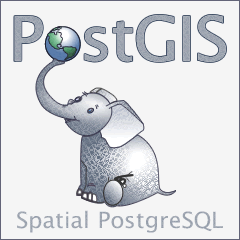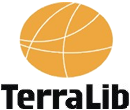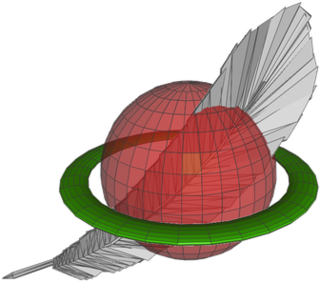Related Research Articles

PostgreSQL, also known as Postgres, is a free and open-source relational database management system (RDBMS) emphasizing extensibility and SQL compliance. PostgreSQL features transactions with atomicity, consistency, isolation, durability (ACID) properties, automatically updatable views, materialized views, triggers, foreign keys, and stored procedures. It is supported on all major operating systems, including Linux, FreeBSD, OpenBSD, macOS, and Windows, and handles a range of workloads from single machines to data warehouses or web services with many concurrent users.

Ingres Database is a proprietary SQL relational database management system intended to support large commercial and government applications.

PostGIS is an open source software program that adds support for geographic objects to the PostgreSQL object-relational database. PostGIS follows the Simple Features for SQL specification from the Open Geospatial Consortium (OGC).
A coverage is the digital representation of some spatio-temporal phenomenon. ISO 19123 provides the definition:
A GIS file format is a standard for encoding geographical information into a computer file, as a specialized type of file format for use in geographic information systems (GIS) and other geospatial applications. Since the 1970s, dozens of formats have been created based on various data models for various purposes. They have been created by government mapping agencies, GIS software vendors, standards bodies such as the Open Geospatial Consortium, informal user communities, and even individual developers.

TerraLib is an open-source geographic information system (GIS) software library. It extends object-relational database management systems (DBMS) to handle spatiotemporal data types.
The following tables compare general and technical information for a number of relational database management systems. Please see the individual products' articles for further information. Unless otherwise specified in footnotes, comparisons are based on the stable versions without any add-ons, extensions or external programs.
A GIS software program is a computer program to support the use of a geographic information system, providing the ability to create, store, manage, query, analyze, and visualize geographic data, that is, data representing phenomena for which location is important. The GIS software industry encompasses a broad range of commercial and open-source products that provide some or all of these capabilities within various information technology architectures.
ArcSDE is a server-software sub-system that aims to enable the usage of Relational Database Management Systems for spatial data. The spatial data may then be used as part of a geodatabase.
In computing, GiST or Generalized Search Tree, is a data structure and API that can be used to build a variety of disk-based search trees. GiST is a generalization of the B+ tree, providing a concurrent and recoverable height-balanced search tree infrastructure without making any assumptions about the type of data being stored, or the queries being serviced. GiST can be used to easily implement a range of well-known indexes, including B+ trees, R-trees, hB-trees, RD-trees, and many others; it also allows for easy development of specialized indexes for new data types. It cannot be used directly to implement non-height-balanced trees such as quad trees or prefix trees (tries), though like prefix trees it does support compression, including lossy compression. GiST can be used for any data type that can be naturally ordered into a hierarchy of supersets. Not only is it extensible in terms of data type support and tree layout, it allows the extension writer to support any query predicates that they choose.
Simple Features is a set of standards that specify a common storage and access model of geographic features made of mostly two-dimensional geometries used by geographic databases and geographic information systems. It is formalized by both the Open Geospatial Consortium (OGC) and the International Organization for Standardization (ISO).
JTS Topology Suite is an open-source Java software library that provides an object model for Euclidean planar linear geometry together with a set of fundamental geometric functions. JTS is primarily intended to be used as a core component of vector-based geomatics software such as geographical information systems. It can also be used as a general-purpose library providing algorithms in computational geometry.
Oracle Spatial and Graph, formerly Oracle Spatial, is a free option component of the Oracle Database. The spatial features in Oracle Spatial and Graph aid users in managing geographic and location-data in a native type within an Oracle database, potentially supporting a wide range of applications — from automated mapping, facilities management, and geographic information systems (AM/FM/GIS), to wireless location services and location-enabled e-business. The graph features in Oracle Spatial and Graph include Oracle Network Data Model (NDM) graphs used in traditional network applications in major transportation, telcos, utilities and energy organizations and RDF semantic graphs used in social networks and social interactions and in linking disparate data sets to address requirements from the research, health sciences, finance, media and intelligence communities.
An object-based spatial database is a spatial database that stores the location as objects. The object-based spatial model treats the world as surface littered with recognizable objects, which exist independent of their locations.
A geographic data model, geospatial data model, or simply data model in the context of geographic information systems, is a mathematical and digital structure for representing phenomena over the Earth. Generally, such data models represent various aspects of these phenomena by means of geographic data, including spatial locations, attributes, change over time, and identity. For example, the vector data model represents geography as collections of points, lines, and polygons, and the raster data model represent geography as cell matrices that store numeric values. Data models are implemented throughout the GIS ecosystem, including the software tools for data management and spatial analysis, data stored in a variety of GIS file formats, specifications and standards, and specific designs for GIS installations.

SpatiaLite is a spatial extension to SQLite, providing vector geodatabase functionality. It is similar to PostGIS, Oracle Spatial, and SQL Server with spatial extensions, although SQLite/SpatiaLite aren't based on client-server architecture: they adopt a simpler personal architecture. i.e. the whole SQL engine is directly embedded within the application itself: a complete database simply is an ordinary file which can be freely copied and transferred from one computer/OS to a different one without any special precaution.

The Dimensionally Extended 9-Intersection Model (DE-9IM) is a topological model and a standard used to describe the spatial relations of two regions, in geometry, point-set topology, geospatial topology, and fields related to computer spatial analysis. The spatial relations expressed by the model are invariant to rotation, translation and scaling transformations.

An array database management system or array DBMS provides database services specifically for arrays, that is: homogeneous collections of data items, sitting on a regular grid of one, two, or more dimensions. Often arrays are used to represent sensor, simulation, image, or statistics data. Such arrays tend to be Big Data, with single objects frequently ranging into Terabyte and soon Petabyte sizes; for example, today's earth and space observation archives typically grow by Terabytes a day. Array databases aim at offering flexible, scalable storage and retrieval on this information category.
GeoSPARQL is a standard for representation and querying of geospatial linked data for the Semantic Web from the Open Geospatial Consortium (OGC). The definition of a small ontology based on well-understood OGC standards is intended to provide a standardized exchange basis for geospatial RDF data which can support both qualitative and quantitative spatial reasoning and querying with the SPARQL database query language.
A Geodatabase is a proprietary GIS file format developed in the late 1990s by Esri to represent, store, and organize spatial datasets within a geographic information system. A geodatabase is both a logical data model and the physical implementation of that logical model in several proprietary file formats released during the 2000s. The geodatabase design is based on the spatial database model for storing spatial data in relational and object-relational databases. Given the dominance of Esri in the GIS industry, the term "geodatabase" is used by some as a generic trademark for any spatial database, regardless of platform or design.
References
- ↑ McKee, Lance (2016). "OGC History (detailed)". OGC. Retrieved 2016-07-12.
[...] 1997 [...] OGC released the OpenGIS Simple Features Specification, which specifies the interface that enables diverse systems to communicate in terms of 'simple features' which are based on 2D geometry. The supported geometry types include points, lines, linestrings, curves, and polygons. Each geometric object is associated with a Spatial Reference System, which describes the coordinate space in which the geometric object is defined.
- ↑ OGC Homepage
- ↑ Kresse, Wolfgang; Danko, David M., eds. (2010). Springer handbook of geographic information (1. ed.). Berlin: Springer. pp. 82–83. ISBN 9783540726807.
- ↑ Yue, P.; Tan, Z. "DM-03 - Relational DBMS and their Spatial Extensions". GIS&T Body of Knowledge. UCGIS. Retrieved 5 January 2023.
- ↑ Zhang, X.; Du, Z. "DM-66 Spatial Indexing". GIS&T Body of Knowledge. UCGIS. Retrieved 5 January 2023.
- ↑ Güting, Ralf Hartmut; Schneider, Markus (2005). Moving Objects Databases. Morgan Kaufmann. p. 262. ISBN 9780120887996.
- ↑ "PostGIS Function Reference". PostGIS Manual. OSGeo. Retrieved 4 January 2023.
- ↑ Drill Geospatial Function Documentation
- ↑ "Geo queries | Elasticsearch Guide [7.15]| Elastic".
- ↑ H2 geometry type documentation
- ↑ H2 create spatial index documentation
- ↑ "GeoSpatial – MonetDB". 4 March 2014.
- ↑ "MySQL 5.5 Reference Manual - 12.17.1. Introduction to MySQL Spatial Support". Archived from the original on 2013-04-30. Retrieved 2013-05-01.
- ↑ OpenLink Software. "9.34. Geometry Data Types and Spatial Index Support" . Retrieved October 24, 2018.
- ↑ OpenLink Software (2018-10-23). "New Releases of Virtuoso Enterprise and Open Source Editions" . Retrieved October 24, 2018.
- ↑ "OGC Certified PostGIS".
- ↑ "Command reference – Redis".
- ↑ "SAP Help Portal" (PDF).
- ↑ "RTREE". tarantool.org. Archived from the original on 2014-12-13.
- ↑ "HP Vertica Place". 2 December 2015.
- ↑ "GEOS".
- ↑ "Neo4j Spatial is a library of utilities for Neo4j that facilitates the enabling of spatial operations on data. In particular you can add spatial indexes to already located data, and perform spatial". GitHub . 2019-02-18.
- ↑ "ReQL command reference - RethinkDB".